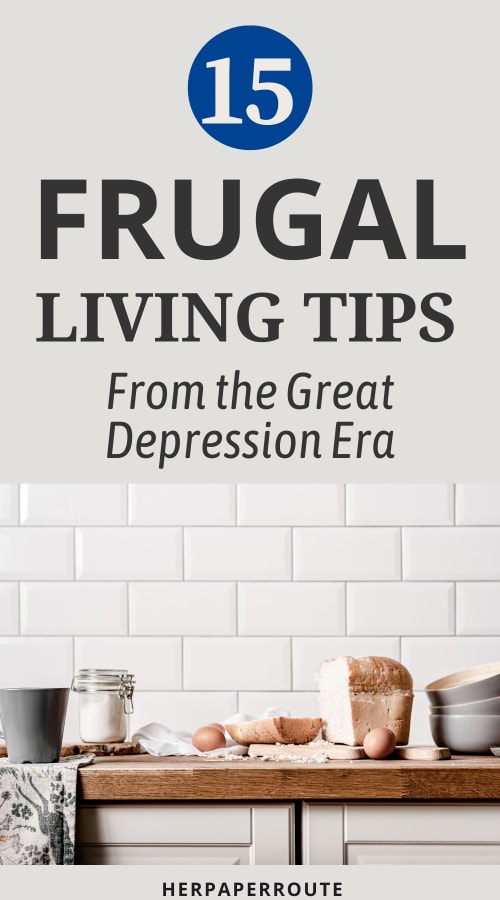15 Frugal Living Tips From The Great Depression Era To Save Money

The Great Depression Era was a time when many of our grandparents and great-grandparents had little money.
They needed to use smart frugal money tips to survive and keep their households running.
As an affiliate partner of various brands and sponsored content, HerPaperRoute may earn commission on qualifying purchases. Disclaimer
Not too long after this timeframe, World War II started. This meant a long period where many were in poverty and people used creative tricks to save money.

Creative Ways On How To Save Money From Your Grandparents
Opposite of today’s consumer culture, our grandparents would mend, reuse, repurpose, borrow, and upcycle everything to get the maximum use out of an item.
Best Frugal Living Tips From Your Thrifty Grandma:
1) Grow A Garden
Gardening was a staple of the Great Depression Era. If you had space, you were wise to have a garden. Money was tight so fresh produce from the market was out of reach for many.
Gardening, on the other hand, was something you could start inexpensively. You could share seeds and plants with neighbors. If you produced too much of one vegetable, you could barter and trade with your neighbors for something else.
Today, gardening is still a viable option for saving money. If you like eating organic produce, it is even more prudent to grow your own since the savings are massive.
Did you know that one zucchini plant can produce 10 pounds of produce? Organic heirloom tomatoes are
The chart below shows how much it would cost from the grocery store to purchase the same amount of organic produce one plant produces.
| Produce | Lbs Per Plant | Cost per Lb | Total | |
| Zucchini | 10 | $2 | $20 | |
| H. Tomatoes | 25 | $6 | $150 | |
| Bell Peppers | 4 | $7.50 | $30 |
I often get my organic vegetable plants between $3-$6.50 each. By planting your own vegetable garden, you can save around $185 with these three crops alone! Starting plants from seed is even more economical.
Short on space? It’s a myth that you must have a vast patch of land in order to make home gardening worthwhile. A small container garden will still produce savings.
I have underground utilities running through my backyard so I use raised bed gardens to work around not being able to dig down.
Here are some helpful resources for gardening:
- Start your own plants from seeds with these DIY seed starting pots.
- Plan out your vegetable garden each year using simple steps.
- Grow and store garlic and onions to have fresh flavorings all year.
2) Plant An Herb Garden
On the same note as above, having an herb garden is another money saver. Fresh herbs taste better but can sometimes be too costly.
A few leaves of basil can run $2. Forget about making fresh pesto that requires cups of basil!
Luckily, herbs can be grown indoors by a sunny window despite a lack of a green thumb. Indoor growing also has the advantage of producing herbs
3) Forage For Food
This money-saving tip intrigues me the most. Many of the plants we think of as “weeds” are just as edible and nutritious as the mass cultivated plants in grocery stores.
I’m sure you’ve seen dandelion greens in the store. Those are no different than the dandelions deemed “weed” from your yard.
It’s important to note that heading outside and tasting plants is a good way to get sick. Take the time to understand what you’re looking for and properly identify the plants.
4) Cook At Home
Our grandparents only ate out for very special occasions. It was considered a treat. Something out of the norm and not a weekly or everyday occurrence.
Cooking at home is one of the most
If
Work, stress, and shuttling kids back and forth are all reasons to eat out. With a little planning, eating at home can save a lot of money.
By batch cooking and doubling recipes, you can be sure to have enough leftovers for the next night and work lunches.
5) Learn To Can
Canning was a large part of home life in the Depression Era. Our grandparents’ canned leftover produce into jams, salsas, sauces, purees, and fermented foods.
Perhaps canning appeals to you but you’re frightened of not doing it right? The risk of improper canning is botulism but following reputable
6) Make Your Own Cleaning Products
Many homemade cleaners work just as well as store
Considering that a bottle of eco-friendly store-bought cleaner can be over $5 a bottle, you can make MANY bottles of cleaner using a $1 gallon jug of white vinegar.
- For bathroom tile, sprinkle baking soda and then spritz with the vinegar spray for some foaming action.
7) Repurpose And Upcycle Items
Every person produces an estimated 4.4 lbs of solid waste EVERY DAY!
There are some very creative ideas out there and you’re limited only by your imagination.
- If you have a lot of t-shirts lying around, they could be cut into strips and made into a unique area rug.
Thrift stores and flea markets are the perfect locations to find items that can be good as new with a little care.
8) Repair Damaged Items
In our grandparent’s upbringing, if something broke or wore out, you’d find a way to fix it. Items were built for quality and fast fashion wasn’t even an idea.
If your chair broke, you’d fix it. Clothing would be mended and patches added. Learning to sew and general
One of my favorite garage sale finds
With a little TLC, the cast iron is easily brought back to its former glory. Since they were “ugly” and rusted, you can usually negotiate the price down.
9) Complete Tasks Yourself
Instead of hiring out, learn how to do tasks around the house for yourself such as painting and other maintenance tasks.
Sources such as YouTube are great to learn how to fix a leaking sink or change your car’s burnt-out headlight.
Many of the tasks we outsource can be done by us with only a little bit of forethought.
10) Save On Utilities
It’s no secret that turning off a light when you leave a room and not leaving water running saves money. Perhaps start thinking even more frugally.
In the Depression Era, single household laundry rooms with washers and dryers were only a dream. Your options were washboard or be dirty. Drying clothes was done outside in the sun or indoors during bad weather.
I’m not suggesting we abandon our electric washers, only pointing out that d
During nice weather, instead of running your dryer, hang your clothes outside to dry. Here are guides for building your own clothesline and repurposing an old pair of khakis into a clothespin bag.
11) Make Your Gifts
Who doesn’t love a homemade gift? I’m not talking about macaroni picture frames. Although if that’s your thing, go for it.
Today’s society is very
Homemade gifts are the way to go if you want to save money gift giving. Handmade gifts are also more special since the gift giver spent their time creating it.
12) Don’t Waste
Purposefully wasting something was unheard up in our grandparent’s time. Take a page from their book and reduce your waste.
Before you’re about to throw something away, think of whether the items can be used in a different way instead of filling up a landfill.
- Make sure to use all of a product up before tossing it. This tool is perfect for getting every last bit.
- Use less product than you think you need. Often times, your hair would be equally as clean had you used half the amount of shampoo.
- Vegetable scraps can be saved for making broth.
- Table scraps can be composted.
- Extra produce/herbs can be saved and stored for later use.
13) Purchase Reusable Products
Why waste your money on an item you’re going to throw away? Instead, invest in cloth napkins for mealtime and washable rags for cleaning tasks around the house.
Reusable grocery and produce bags keep you from having to use plastic bags
14) Opt For Free Entertainment
Every weekend doesn’t need to be filled with expensive outings. Some budget-friendly options include hiking, bird watching, visiting the beach or lake, board games, and local festivals.
Chances are, your friends are ALSO looking for fun things to do that don’t cost money. It’s a great way to take advantage of what your local community has to offer.
Related: For free (or super cheap) date night ideas, check out this list.
15) Determine If You Need It
Is this a fleeting want or something you can’t do without? Do you want it because you NEED it or is it because someone you know has the item?
In the Depression Era, they didn’t buy new clothes as a source of entertainment. They bought new clothes because the old ones were so worn out they couldn’t be mended anymore.
Training yourself to reflect upon the reasons WHY you want an item, is a way to make your spending more conscious. It’s easier to say no this way as well.
Saying “no” allows you to live within your means and not rack up debt. Nothing is further from your frugal grandparents than debt.
They paid for things in cash. If they didn’t have the cash, then they didn’t get the item.
15 Frugal Living Tips From The Great Depression Era – Conclusion
While you may not be keen to try everything on this list, implementing even a few of these tips from your thrifty grandma will save you money.
Your grandparent’s frugal secrets are still valid today despite the vast technological changes since then.
These thrifty tips don’t require you to live a life of deprivation and mostly involve small changes to your routine.
If you’d like more frugal tips, check out these essential tips from The Tightwad Gazette that stand the test of time.
I’d love to hear your frugal living tips from your grandparents or great-grandparents in the comments!

Follow along on Instagram!








![Try This $5 Savings Challenge [With Printable] 10 Image of a $5 savings challenge jar](https://herpaperroute.com/wp-content/uploads/2022/09/Try-This-5-Savings-Challenge-768x410.png)

